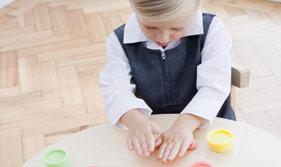Reprinted from:
A way with words

Many well-meaning grown-ups will have bought books as Christmas presents for children this year, hoping that kids will still enjoy a good old-fashioned read in the 21st century.
But for many youngsters, the idea of reading will fill them with dread. And not just because they would rather be playing computer games.
Reading and writing can become tough for an estimated one in ten people who are classed as having dyslexia. Many have been wrongly labelled as stupid because of their difficulties, even though the individuals are often of above-average intelligence.
The term dyslexia simply means difficulty with words, and the most obvious problems are with reading, spelling and writing.
But one method of dealing with dyslexia takes a different approach by looking at the condition not as a learning difficulty, but as a gift.
The method, devised by dyslexic Ron Davis, claims to have a 97 per cent success rate with its teaching, which is based around people with dyslexia thinking in pictures, rather than words. It looks like great fun, with plenty of clay involved in the learning process.
Dubai-based Linda Rademan is a Davis Dyslexia Facilitator, and she loves the approach. She explains: “The Davis programme would use clay as a three-dimensional tool to be able to translate a lot of what the children need to understand into a picture. It’s a very hands-on, child-friendly process. Kids absolutely love it.
Most that come to me don’t want to go home at the end of our session and you can be talking about kids with real difficulties. It’s really good fun and there’s a great sense of discovery.
“I’ve done this now for eight years and the more I got to deal with it the more I realised it was true. “If they see nothing then they can’t understand the process. When they read they don’t create any image in their mind as to what they are reading or follow the story in any pattern.
So although they decode the word there is no meaning behind those words.”
Self-esteem is a real issue for some children, especially if classmates think they ‘cannot read’. And Linda believes the programme will help children feel better about themselves. She explains: “Some of the children will make a significant improvement while for others it is marginal.
But it’s not a magic cure, it is a progressive system and you will see improvement, in particular in self-esteem. The children are not stupid and are very able in some cases, but they just have a style of learning which is not catered for in school.
“These kids have difficulty with the auditory teaching, and suddenly they realise if things are converted into the visual then they are able to do it and normally there is a big jump in self-esteem when kids leave and that will obviously generate motivation, which is going to allow them to continue to use the process and improve other aspects of their learning.”
Problems with reading and writing do not disappear after school hours, and parents are urged to get involved with their children if they are trying to cope with the issue of dyslexia.
Linda says: “It can depend on the amount of follow up work that a child does. It’s a bit like taking golf lessons. If I gave you 40 hours of lessons but you took six months before you picked up a golf club again you are going to forget what you were taught. With practice, however, you are going to become a pretty good golfer and it is the same scenario.
The child will be able to do what they do when they leave but then you need to continue with the programme, using the same mode of teaching so the child or young adult understands what they are doing. They need to continue that process. Having dyslexia is like having blue eyes, you are not going to change.
You will still be dyslexic but the way you learn to operate is going to make a difference.”
****
A new method
Dyslexic Ron Davis, was ‘functionally illiterate’ at school.
But the American discovered a way to switch off the mental processes that caused him to see printed words in a distorted way. He says: “People who develop dyslexia think in pictures rather than words. They are imaginative and creative, and try to solve problems by looking at the whole picture, rather than working step-by-step.
In order to understand the gift of dyslexia, we need to view the learning disability from a different angle. It is the result of a perceptual talent. In some situations, the talent becomes a liability.”


